🪐 In the world of digital marketing, understanding the distinction between “soft bounce” VS “hard bounce” is essential to optimizing your strategy and maintaining a good reputation. 💎
Picture this. 💭 You’ve just launched a major email marketing campaign.
After several weeks of work on content, design and targeting… You run into problems shortly after launching the emails. 😬
You start receiving dozens of “soft bounce” and “hard bounce” notifications. And then panic! 😱
- You have no idea what it is and/or how to solve these issues.
- You’re worried that these problems will affect the company’s objectives and image.
- Or that they prevent you from achieving reliable, measurable results.
It’s also essential to know what actions you have to do to avoid and remedy them. 🛠️ This obviously involves choosing the right tool, and knowing how to handle your mailings.
⬇️ We’ve got all the answers! On the program :
- Definition of Soft Bounce VS Hard Bounce.
- Best tips to avoid and/or remedy them.
- Solution to treat them with Waalaxy.
Looking forward to it? Me too, so let’s get started! 🤩
Soft Bounce VS Hard Bounce: meaning and difference
These two terms describe the errors that can be encountered when sending emails to a list of contacts. ❌ They have various consequences for your marketing strategy and data management.
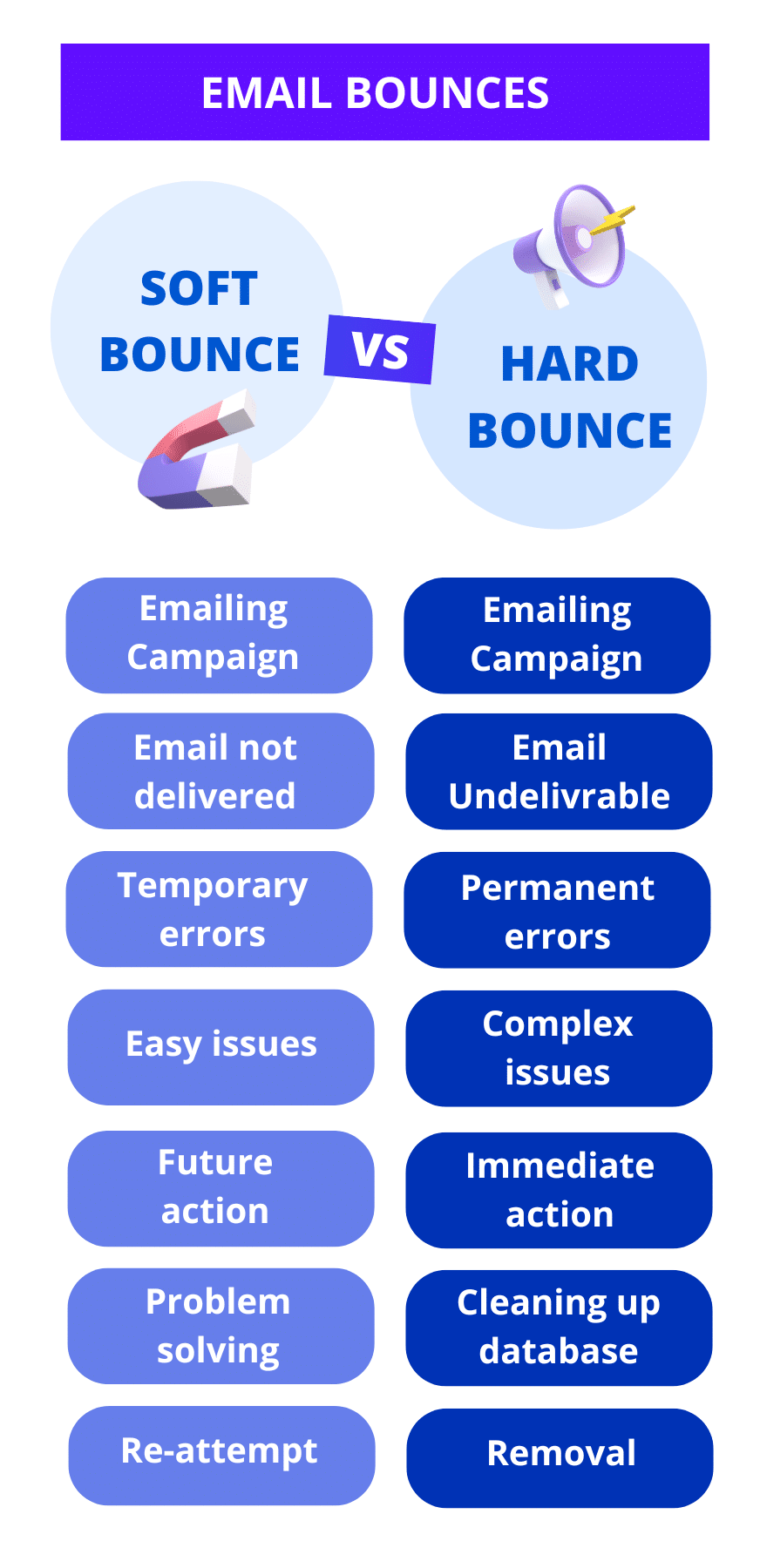
Definition of Soft Bounce
A soft bounce is generally the result of temporary problems with the recipient’s email address or email server. ⌛️ This is an indicator that the email has not been delivered.
👉🏼 The main causes of a soft bounce are not necessarily permanent and include:
- Full mailbox : email server temporarily rejects message until space is freed.
- Issue with email server downtime or maintenance.
- Message size : body text that exceeds the size limit imposed by the email server.
- Filters: temporary content-related rejection (such as suspicious links or attachments).
These issues can be solved quickly, but of course, meanwhile, the e-mails marketing campaign in question don’t reach their targets. 🤷🏻♀️
🔎 We therefore advise you to monitor these email addresses to see if the problem persists. In which case, they could possibly become candidates for removal from the database to avoid future email delivery problems. 📨
Definition of Hard Bounce
A hard bounce reflects a more serious and often permanent problem. 🫠 This is an indicator meaning that the email is undelivrable to the specified email addresses.
This means, firstly, that the email campaign is not reaching all recipients, but also that the data contains errors that need to be rectified as quickly as possible. ⏱️
👉🏼 Common causes of a hard bounced emails are :
- Invalid address: when the email address does not exist, has been entered incorrectly, or has been closed.
- Non-existent domain : if an email is sent to a domain that does not exist or is misspelled.
- Server policies : some email servers may automatically reject all incoming emails from unknown or unapproved sender (see for example for the Outlook server).
🤨 These errors are more problematic for specialists, as they signal complex issues that require immediate action (unlike soft bounced emails).
🚨 It’s crucial to immediately remove email addresses that generate hard bounce from your contact portfolio.
Not doing so could jeopardize your domain’s reputation and reduce your overall deliverability potential, i.e. your ability to reach your contacts’ inboxes. ❌
Mail service providers evaluate sender quality in part by the bounce rate. That’s why it’s absolutely essential to correct soft bounce and hard bounce problems! 👇🏼
How to avoid email bounces in your campaigns?
Once the moment of panic has passed, after all this negative feedback, and you’ve learned the difference between hard bounce VS soft bounce… 😮💨 What can I do about it?
Analyze and optimize
🧐 First, we analyze the error reports, identifying the reasons for the bounces and look for solutions to improve data quality. Then, when all the reasons have been identified, we act immediately to minimize the impact of these problems:
- Segment e-mails that have generated hard bounces to clean up data.
- Plan a second wave to send e-mails that have generated soft bounces again, once the issues have been resolved.
These measures will enable you to save time, improve optimization, and therefore increase the effectiveness of your future email marketing campaigns.💥
Improving results
🎯 To continually improve the performance of your e-mails and the results of your marketing campaigns. You can implement various actions:
- Consult experts for tailor-made advice.
- Establish a routine for checking email addresses before sending your campaign to save time. To help you, you can use a mail tester.
- Invest in advanced tools to automate the verification, identification, and cleaning of your email address lists.
😁 It’s on this last point that we’re going to focus a little.👇🏼
Use third-party automation tools
It’s more than advisable to use marketing automation tools to effectively manage your email campaigns as well as any errors that may occur. 🤖 Some of them can :
- Classify and react to e-mail bounces appropriately.
- Keep distribution lists clean and efficient.
- Optimize open/response rates.
- Minimize costs associated with unsuccessful mailings.
And, of course, the Waalaxy tool can do it all! 🤩 We’ll take this opportunity to show you how!👇🏼
How to handle email bounces with Waalaxy?
Waalaxy is a must-have to facilitate your prospecting, especially for automating retrieval and email sending ! 🚀
But also to identify and deal with deliverability errors (soft bounce VS hard bounce) in your campaigns. ✨
Track the delivery and performance of email campaign on Waalaxy
➡️ Once you’ve chosen your sequence, set up and launched your email campaign, they’re placed in another queue and sent out progressively.
When they’ve all been sent, you’ll be able to find all the information on your home page, in the email statistics tab 📊 :
- Rate and number of emails answered.
- The rate and number of emails delivered correctly.
- Bounce rate and number of undelivered/bounced emails (our famous hard bounce VS soft bounce).
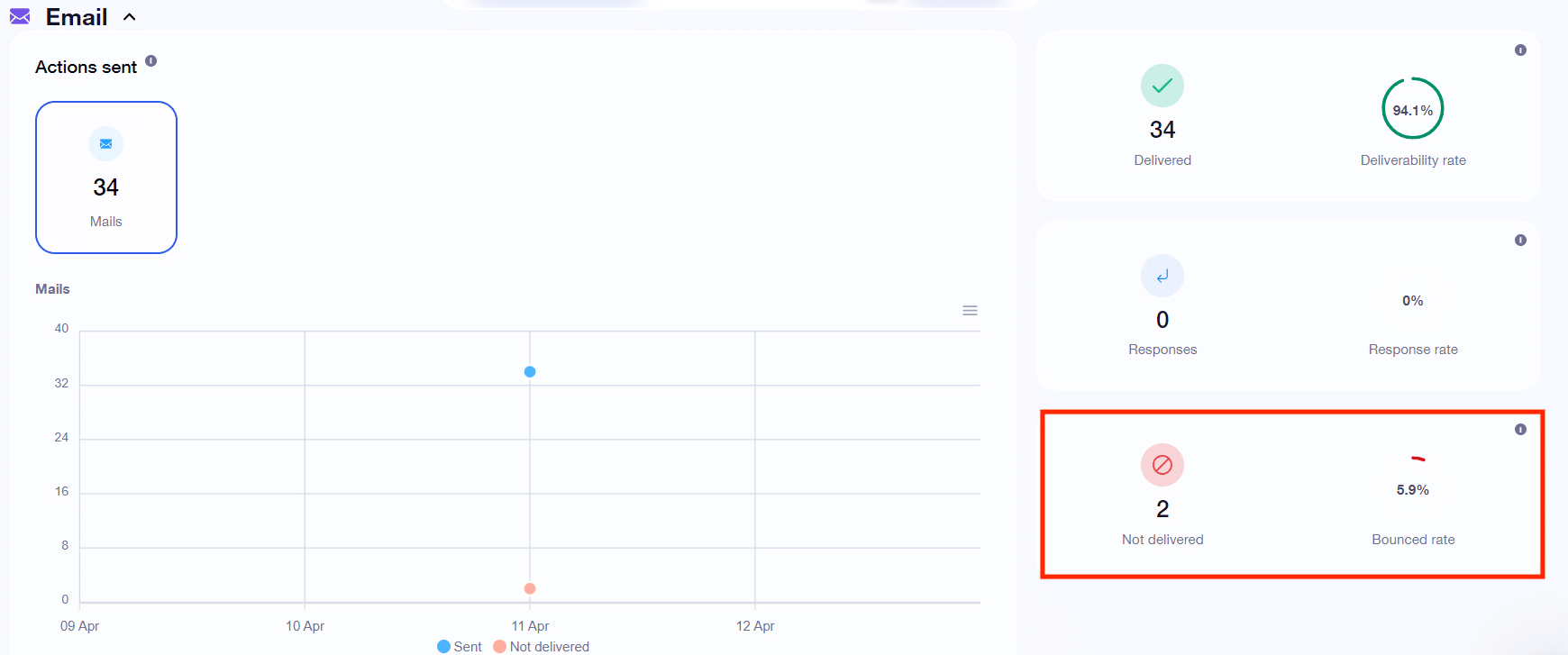
How can I access the details of email deliverability errors on Waalaxy?
Waalaxy can’t track certain information: such as reasons and nature of bounces, open rate etc. 😞
However, if you’d like to get the details of error reasons, Waalaxy offers you the possibility of integrating the platform with various CRM tools that can! 🎉
- On Salesforce Email Studio: temporary, blocking and technical bounces.
- On Pipedrive: soft, hard, temporary, blocking bounces.
- On Zoho Zepto Mail: connection problems, strategy failure, spam, user not found, invalid DNS, other.
- …
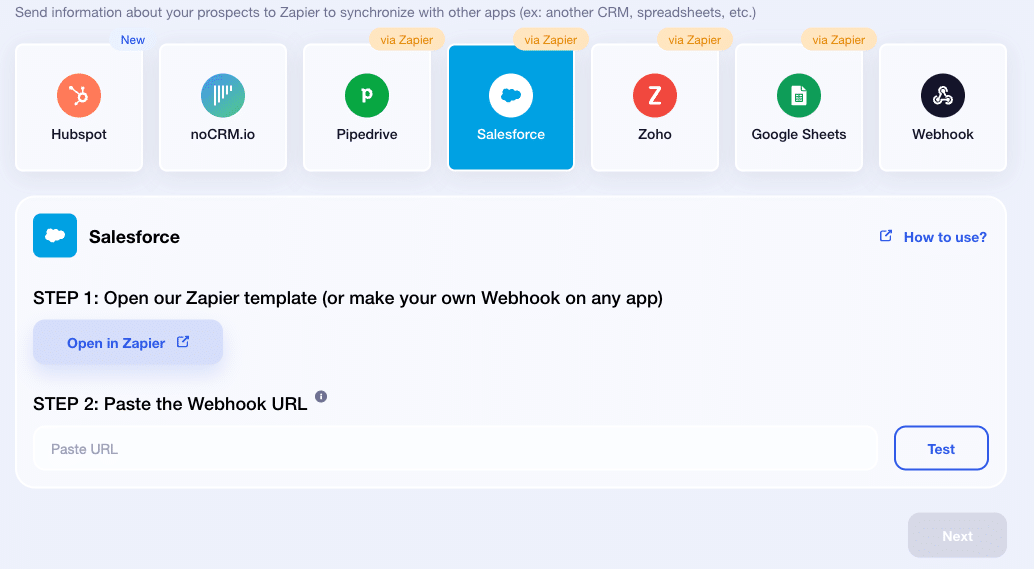
✅ This way, you’ll know how to handle errors and what actions to take on your database, directly in Waalaxy!
How do I fix email bounces on Waalaxy?
After using the tool of your choice to identify undelivered/bounced emails and the reasons for the errors generated (or even to resolve these errors). ⚙️
🧼 You can now clean up your data and update your contact lists on Waalaxy, creating lists to extract emails :
- Having caused soft bounces (and previously corrected), to plan/resend the prospecting campaign in question.
- Having caused hard bounces, plan to stop trying to contact them.
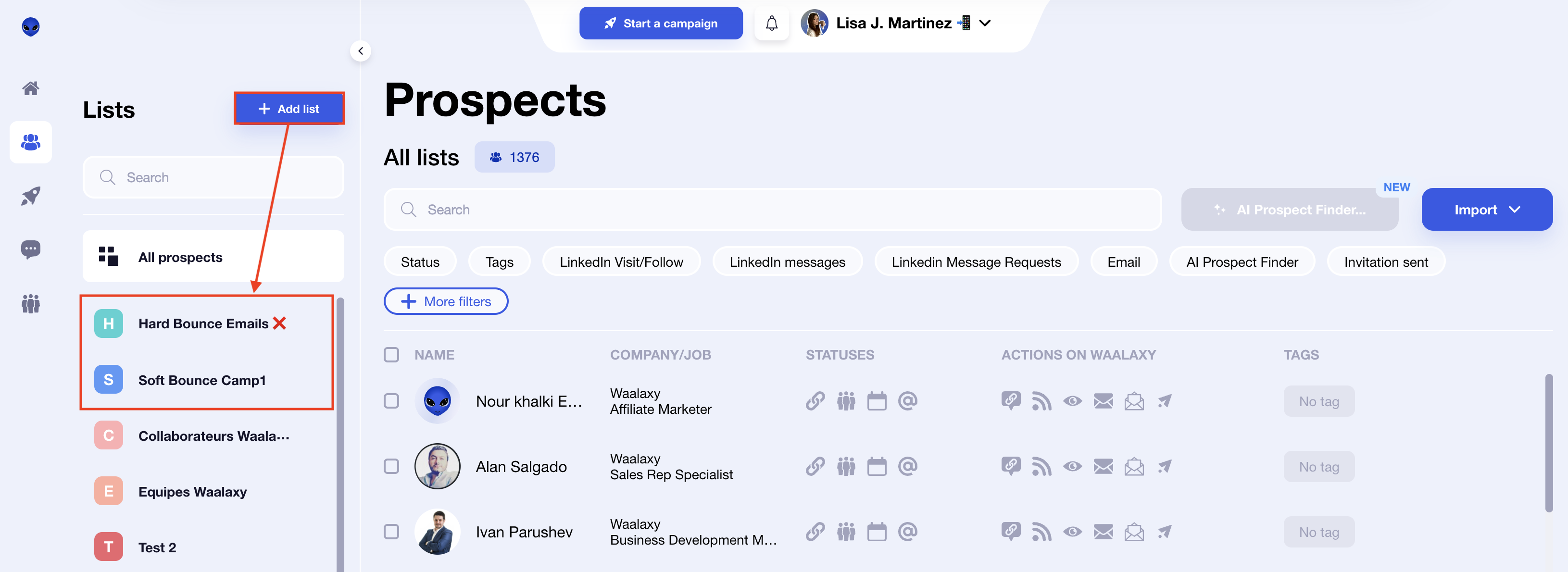
So you can easily monitor performance and periodically reassess the quality of your data! 💎
If you want to totally eradicate soft bounce and hard bounce (or almost), we recommend you change and/or diversify your strategy by launching opt-in (by email or via LinkedIn messaging). ☑️
This is the opposite of cold mailing (AKA outreach marketing), which is Waalaxy’s specialty 😉 But the tool also gives you the opportunity to launch this type of marketing campaign!
Conclusion : Why use Waalaxy rather than another solution to manage your e-mail campaigns?
👽 Waalaxy is a Google Chrome extension, available in free and subscription versions! The tool enables the automation of prospecting campaigns via LinkedIn and Email (in complete security). 🔐
The solution has been designed for different types of customer: sales, marketers, managers, agencies, recruiters. 💡
It presents itself as the simplest, most intuitive and effective digital solution on the market! 🚀 To use it and launch your various multichannel marketing campaigns, you will NOT need ❌ :
- Pre-existing database.
- Have a technical profile and/or skills.
- Awareness-raising or additional training.
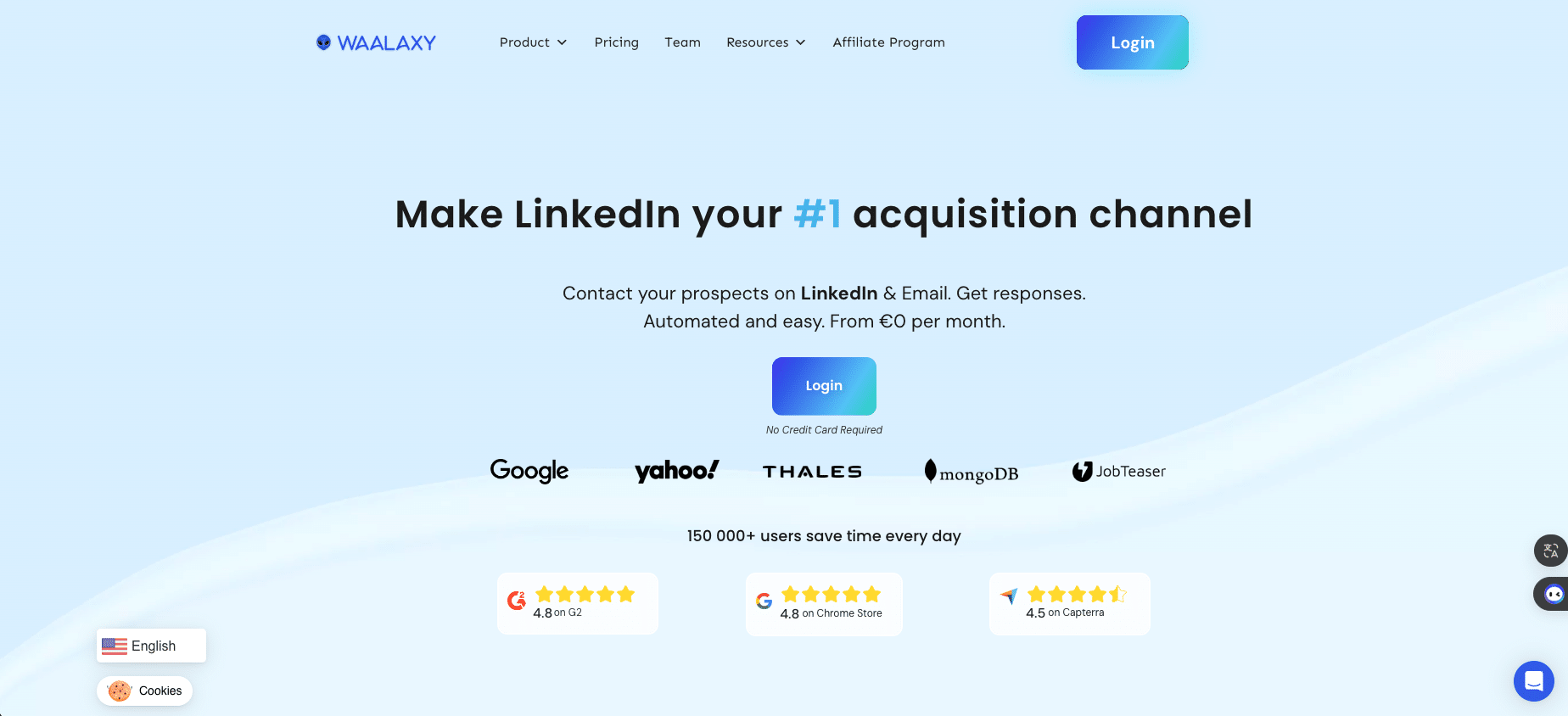
Unlike the majority of tools on the market, it’s accessible to beginners, as well as more advanced profiles. ✅ Here are its main benefits and features:
- Automatic lead import.
- Launch of automated prospecting campaigns (200 invitations/week).
- Optimization and personalization of email messages for conversion.
- Monitoring responses and engagement with LinkedIn messaging.
- Integration and compatibility with other tools.
- Using artificial intelligence to prospect and retrieve emails.
- Accessible interface and high-quality user support with a host of resources for successful prospecting.
- Market leader, the solution with the most satisfied users.
You really don’t want to miss this! 🤩 To try it out, click here! 👇🏼
🎬 Now you know all about soft bounce VS hard bounce (or bounce rate), which can affect your mailing… But also on how to reduce them to improve performance, with Waalaxy! 🚀
Frequently asked questions (FAQ)
What is an email campaign & why launch one?
📨 It’s a digital marketing strategy that involves sending scheduled messages to a list of contacts with the aim of promoting products, services, events, information… or keeping customers engaged.
✅ Launching an email campaign has several advantages:
- Precise targeting : personalized content and send to specific segments, increasing the relevance and effectiveness of email messages.
- Cost-effectiveness : compared to other forms of advertising, email marketing is relatively inexpensive and offers a high return on investment.
- Measurable : every aspect can be tracked and analyzed, enabling strategies to be adjusted according to performance.
- Relationship-building : regular exchanges help to build and maintain a relationship with customers, keeping them informed and engaged.
In short, it’s a powerful tool for achieving marketing objectives, improving customer loyalty, and maximizing revenues with efficiency and adaptability. 🤑
Why measure email deliverability?
Measuring deliverability ensures that messages sent by a company reach recipients’ inboxes.
These measures have a direct impact on performance on several levels ⬇️ :
- Optimization of performance indicators to identify and solve problems preventing your emails from reaching their destination.
- Enhance your sender reputation with email service providers (ESPs), to avoid being marked as spam due to a poor email delivery rate and reduce your future visibility.
- Increase ROI by maximizing the number of people who interact, resulting in a higher open rate and better conversion.
In short, measuring and optimizing this indicator is essential to guarantee the success and effectiveness of your email campaign. 🏆 But also, to identify potential issues and improve your practices.
What makes a successful business email?
💼 A successful professional email is characterized by its clarity, effectiveness and relevance. Here are the elements that define it:
- Body copy : be direct and comprehensible to ensure that all stakeholders understand the subject without ambiguity.
- Precise subject line : the subject line must describe the subject, be informative and captivating to encourage the target to open the message.
- Organized and logical structure, with an introduction, detailed development and a conclusion with a call to action.
- Appropriate tone : the tone should be courteous, adapted to the relationship and the cultural context.
- Signature : the email must end with a professional signature that includes the sender‘s full name, position and contact details.
- Checking: before sending email, you should proofread the text to correct any mistakes and check the relevance of the information.
By following these principles, you’ll be able to communicate effectively, maintain or establish professional relationships, and build a positive professional image. ✨
I hope you find these tips on hard bounce VS soft bounce useful! See you soon. 👽









